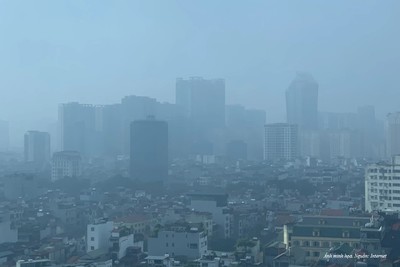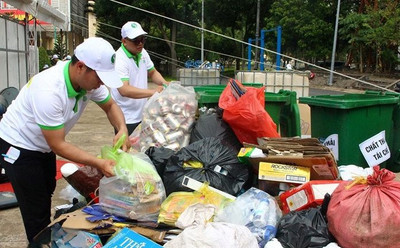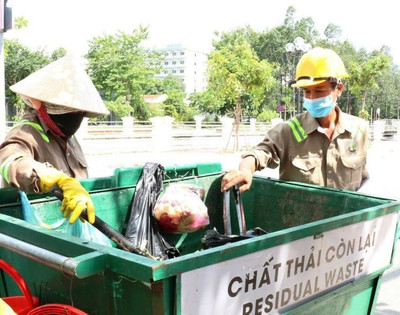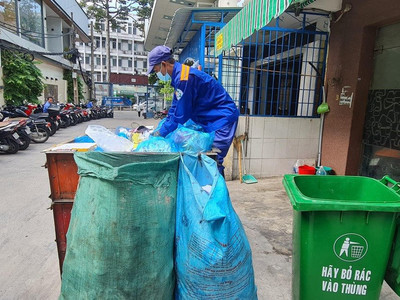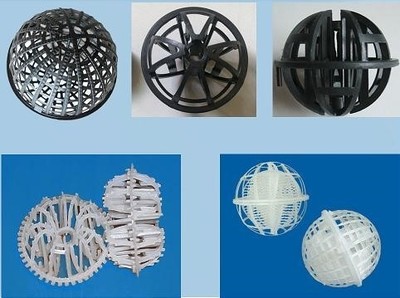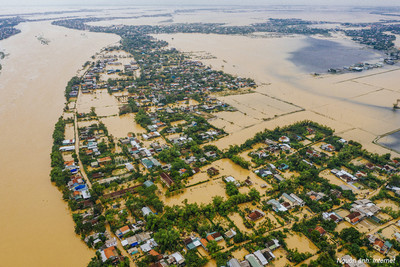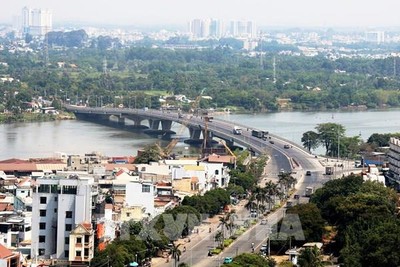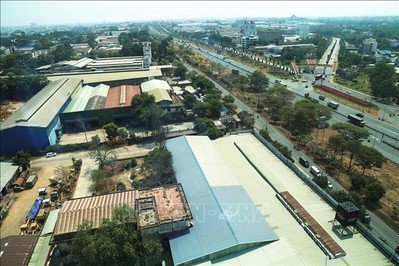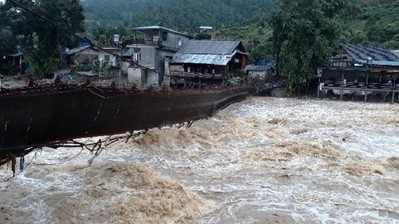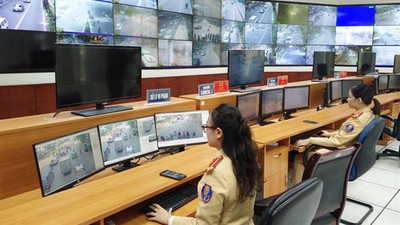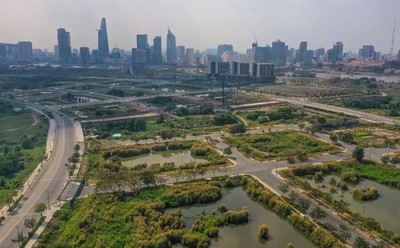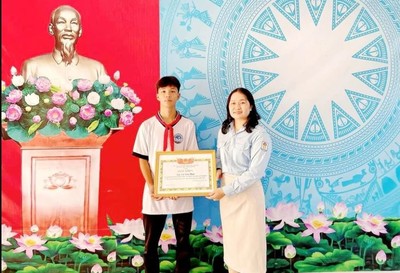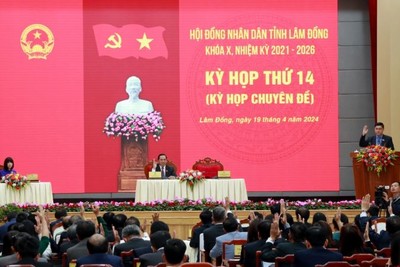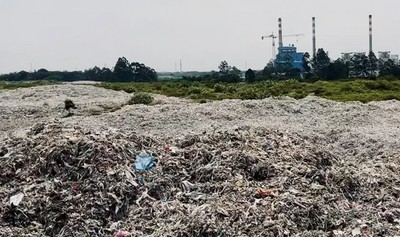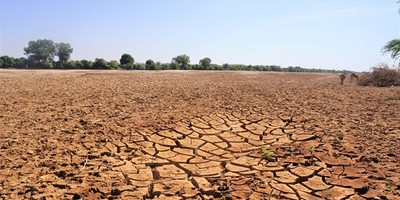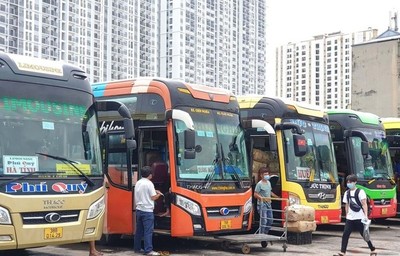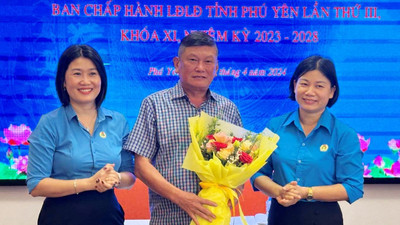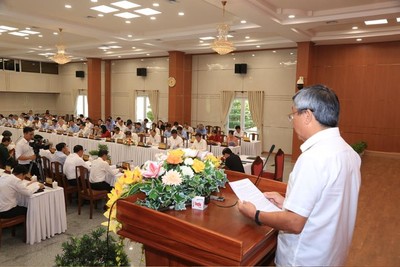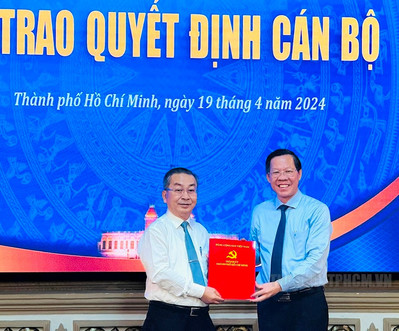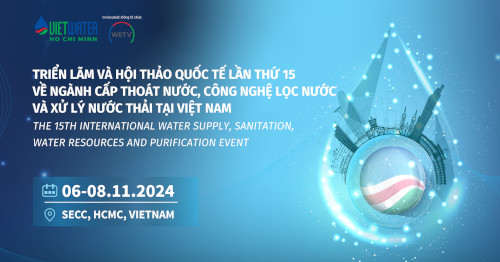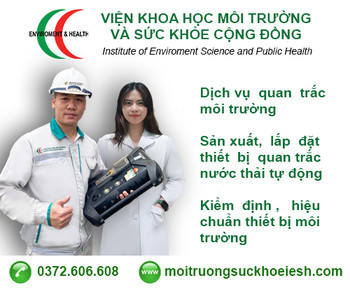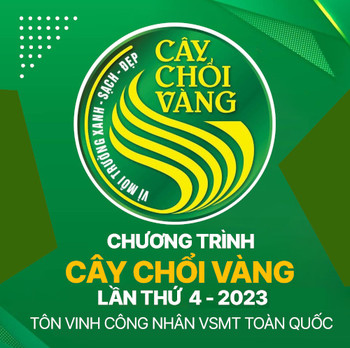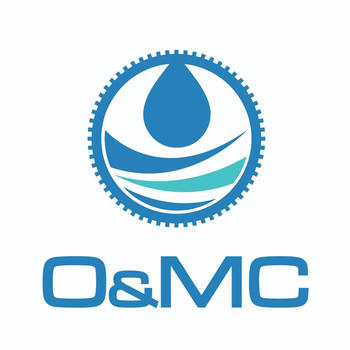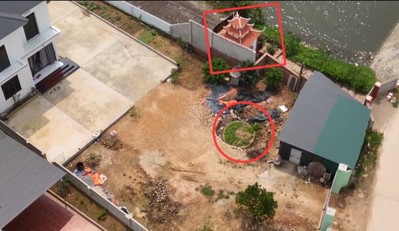Công bố quốc tế lĩnh vực môi trường số 15-2022
Trân trọng giới thiệu tới quý độc giả Công bố Quốc tế lĩnh vực môi trường số 15-2022 với các công trình nghiên cứu của các nhà khoa học nổi tiếng từ nhiều quốc gia khác nhau và đã được công bố trên những tạp chí uy tín thế giới.

Công bố Quốc tế lĩnh vực môi trường số 15-2022 bao gồm 16 bài nghiên cứu về quản lý môi trường, 17 bài về môi trường đô thị và 17 bài về môi trường khu công nghiệp với những nội dung chính như sau:
Về quản lý môi trường
- Tiêu thụ năng lượng tái tạo và toàn cầu hóa tài chính có đóng góp vào sự bền vững sinh thái ở các nước công nghiệp mới không?
- Thuế môi trường và lượng khí thải carbon có liên quan như thế nào trong các nền kinh tế G7?
- Tác động của các quy định về môi trường đối với tăng trưởng kinh tế xanh ở Trung Quốc: Hướng dẫn mới về năng lượng tái tạo và hiệu quả năng lượng.
- Năng lượng tái tạo giảm nghèo năng lượng như thế nào? Một phân tích toàn cầu.
- Nhận thức của người tiêu dùng đối với các dịch vụ thị trường năng lượng thông minh và bền vững: Vai trò của những người sớm áp dụng.
- Phân cấp tài khóa như một yếu tố quyết định mới đối với nhu cầu năng lượng tái tạo ở Trung Quốc: Vai trò của bất bình đẳng thu nhập và đô thị hóa.
- Đánh giá các mô hình học máy để dự đoán bức xạ mặt trời toàn cầu và khuếch tán hàng ngày trong các điều kiện thời tiết / ô nhiễm khác nhau.
- Năng lượng tái tạo, tính ưu việt của đô thị, đầu tư trực tiếp nước ngoài và giá trị gia tăng ở các khu vực Châu Âu.
- Gánh nặng của bão bụi lên nhiều năm cuộc đời bị mất ở Seoul, Hàn Quốc: Phân tích độ trễ phân tán.
- Các con đường hình thành nitrat trong khí quyển trong bầu không khí thành thị và nông thôn ở Đông Bắc Trung Quốc: Hệ lụy cho các tác động phức tạp của con người.
Về môi trường đô thị
- Hấp thụ asen bằng phân trộn và biochars có nguồn gốc từ phần hữu cơ của chất thải rắn đô thị: Nghiên cứu động học, đẳng nhiệt và khả năng tiếp cận sinh học qua đường miệng.
- Nguy cơ sức khỏe khi hít phải BTEX trong một nhà máy xử lý nước thải đô thị ở thành phố Trung Đông: Shiraz, Iran.
- Hấp thụ sinh học chất thải nguy hại từ nước thải đô thị bằng sinh khối tảo biển.
- Nồng độ, sự phân bố và những nguy cơ tiềm ẩn đối với sức khỏe của chất hấp thụ tia cực tím hữu cơ trong bụi đường phố từ Thiên Tân, một siêu đô thị ở miền bắc Trung Quốc.
- Khám phá sự phát triển phối hợp của đô thị hóa và hệ thống môi trường sinh thái ở miền Trung Trung QuốcTiếp xúc với không gian xanh đô thị có thể vừa thúc đẩy vừa gây hại cho sức khỏe tâm thần ở các khu dân cư dễ bị tổn thương về mặt xã hội: Một phân tích quy mô khu vực lân cận ở Thành phố New York.
- Rủi ro tử vong do nhiệt độ môi trường cao và thấp ở thành phố Pune, Ấn Độ: Phân tích theo chuỗi thời gian từ năm 2004 đến năm 2012.
- Đánh giá tác động sức khỏe của tiếng ồn giao thông ở hai thành phố của Estonia.
- Khả năng tiếp cận và sự sẵn có của các cửa hàng bán rượu xung quanh trường học: Một nghiên cứu sinh thái học ở thành phố Madrid, Tây Ban Nha, theo cấp khu vực kinh tế xã hội.
Về môi trường khu công nghiệp
- Công bằng phân phối trong các mối nguy đối với sức khỏe môi trường do ô nhiễm công nghiệp: Đánh giá một cách có hệ thống các đánh giá quốc gia và gần quốc gia về bất bình đẳng xã hội.
- Thu hoạch biohydrogen từ nước thải công nghiệp: Tiềm năng sản xuất, lò phản ứng sinh học quy mô thí điểm, tình trạng thương mại hóa, kinh tế công nghệ và phân tích chính sách.
- Thiết kế và triển khai kiến trúc SDF FFT có đường ống để triệt tiêu tiếng ồn công nghiệp bền vững trong thiết bị trợ thính kỹ thuật số.
- Các cuộc điều tra về chất lượng không khí của một thành phố công nghiệp bị ô nhiễm nghiêm trọng bằng cách sử dụng các phương pháp thống kê đa biến: Con đường hướng tới cho sự bền vững trong tương lai.
- Tác động của Chính sách tiết kiệm năng lượng bắt buộc đối với hiệu quả phân bổ tài nguyên: Bằng chứng từ khu vực công nghiệp Trung Quốc.
- Cải tiến quy trình của máy phân loại rung để phân loại chất thải-khử nước và ứng dụng công nghiệp.
- Một quy trình sạch để thu hồi đồng có chọn lọc từ nước thải công nghiệp bằng cách chiết xuất-kết tủa với axit axetic p-tert-octyl phenoxy.
- Đánh giá năng lực sản xuất và giảm thiểu carbon của các quy trình công nghiệp dựa trên chức năng cơ sở xuyên tâm mới tích hợp quy mô đa chiều.
- Xử lý nước thải công nghiệp hỗn hợp bằng sự kết hợp của quá trình Fenton điện và đông tụ điện không đồng nhất.
Sau đây là tên và phần tóm tắt các bài nghiên cứu bằng tiếng Anh:
QUẢN LÝ MÔI TRƯỜNG
1. Do renewable energy consumption and financial globalisation contribute to ecological sustainability in newly industrialized countries?
Renewable Energy, Volume 187, March 2022, Pages 688-697
Abstract
In this study, the Method of Moments Quantile Regression (MMQR) technique was used to assess the role of financial globalization and renewable energy consumption on ecological footprint in newly industrialized countries (NICs) using annual data from 1990 to 2018. We also incorporated other drivers of ecological footprint, such as natural resources and economic growth. The findings from the MMQR unveiled that financial globalization and renewable energy consumption contribute to environmental quality in each quantile (0.1–0.90), while economic growth and natural resource increase ecological footprint across all quantiles (0.1–0.90). In addition, the Environmental Kuznets Curve hypothesis was validated across all quartiles (0.1–0.90). Similar findings are endorsed by alternative heterogeneous panel estimators, however, their parameters magnitude substantially varied. Additionally, via the route of natural resources, financial globalization is proven to have an indirect positive influence on the environment across middle and higher quantiles (0.4–0.90). Lastly, the panel causality test unveiled that financial globalization, renewable energy, natural resources and economic growth can predict ecological footprint. As a result, the present research's empirical findings can help policymakers understand how renewable energy sources and financial globalization can achieve sustainable economic growth and address environmental issues.
2. How environmental taxes and carbon emissions are related in the G7 economies?
Renewable Energy, Volume 187, March 2022, Pages 645-656
Abstract
This paper explores the impact of an environmental tax on carbon emissions for the G7 nations from 1994 to 2014 and the importance of the major drivers of emissions such as energy use, economic complexity, natural resources rent and economic growth. The study also verifies the Environmental Kuznets Curve Hypothesis for the G7 countries and explores the marginal effects of an environmental tax on traditional energy consumption, natural resources rent and renewable energy consumption. This paper's unique contribution is that it investigates for the first time the moderating role of an environmental tax on renewable and non-renewable energy consumption, natural resources rent and CO2 emissions. The results suggest that environmental taxes effectively reduce emissions for the G7 countries and confirm that the marginal effects of the environmental tax on traditional energy consumption, natural resources rent and renewable energy consumption rise with the level of taxation in a statistically significant way. The findings indicate that strict environmental tax laws will allow businesses to shift production towards cleaner methods. Finally, the paper proposes that redistributing tax revenues to the research and development of sustainable technology programmes would empower the nations to achieve the United Nations' SDG-7 and SDG-13 goals.
3. Impacts of environmental regulations on green economic growth in China: New guidelines regarding renewable energy and energy efficiency
Renewable Energy, Volume 187, March 2022, Pages 728-742
Abstract
As the world's largest energy consuming country, it is important to study the mechanisms of improving renewable energy and energy efficiency to achieve green economic growth in China and globally. Therefore, this study investigates the impact of environmental regulations on green economic growth and renewable energy development in China, respectively. First, this study measures the level of green economic growth in Chinese cities by the Metafrontier-Global-SBM super-efficient data envelopment analysis (DEA) model from the perspective of energy efficiency. And the environmental regulation intensity was measured using an improved fuzzy comprehensive evaluation method. Second, a spatial econometric model based on longitudinal data was constructed to examine the non-linear effects of environmental regulations on green economic growth and its spatial spillover and feedback effects. The results indicated a U-shaped non-linear effect of energy efficiency-related environmental regulation on green economic growth as well as a spatial spillover effect and spatial feedback effect. Finally, the impact of environmental regulation on renewable energy development was investigated. The results show that renewable energy development, an important component of green economic growth, is equally dependent on the implementation of environmental regulation policies and that environmental regulation makes a significant contribution to renewable energy development. The findings of this paper provide a basis for the realization of green economic growth and the formulation of renewable energy policies in China.
4. How renewable energy alleviate energy poverty? A global analysis
Renewable Energy, Volume 186, March 2022, Pages 299-311
Abstract
The development of renewable energy industry is an important measure for countries to strengthen the construction of ecological civilization. Thus, to empirically investigate the underlying effect of renewable energy consumption on global energy poverty alleviation, we first assess the energy poverty composite index across the globe, and then explore whether the rapid development of renewable energy industry can help alleviate energy poverty. The regional heterogeneity and the mediating role of energy efficiency in the renewable energy-poverty alleviation nexus are also discussed. We conclude that: (1) Global energy poverty shows a significant trend of allevia.tion in the sample period, and rapid development of renewable energy industry can help alleviate energy poverty; (2) significant regional heterogeneity exists in the relationship between renewable energy and poverty alleviation. Only in European countries can increased renewable energy significantly reduce energy poverty; and (3) the mediating role of energy efficiency in the renewable energy-poverty alleviation nexus is significant; in other words, renewable energy not only directly alleviates global energy poverty, but also has a significant inhibiting effect on energy poverty by improving energy efficiency. Following the above three conclusions, we provide relevant policies about how to alleviate energy poverty and improve energy efficiency.
5. Perceptions of consumers towards smart and sustainable energy market services: The role of early adopters
Renewable Energy, Volume 187, March 2022, Pages 14-33
Abstract
The aim of this paper is to understand consumer's perceptions towards new energy services. A comprehensive literature review was conducted prior to implementing an online questionnaire with 212 respondents. Consequently, a qualitative in-depth interview was conducted with six representative early adopters of new energy services. The main identified trends in the market were that more than half of the respondents would accept third-party device control but have serious security concerns. Consumers are also willing to invest in renewable energy systems if the payback time is less than 5 years. Factors such as financial rewards and reductions in bills are the main drivers for consumer's acceptance of new services. While, data security and privacy, ignorance of the nature of control and low benefits versus high initial cost were the main barriers. Results of this study would enable the actors in the Egyptian energy domain to identify the consumers' perspectives towards future scenarios and their readiness to be active players in the market. This will in return enable energy actors to adapt their plans based on the questions that current consumers consider relevant as well as decide on how to encourage consumers to become active players in the energy market.
6. Fiscal decentralization as new determinant of renewable energy demand in China: The role of income inequality and urbanization
Renewable Energy, Volume 187, March 2022, Pages 68-80
Abstract
This paper examines the nexus between fiscal decentralization and renewable energy demand by including income inequality, economic growth, urbanization, and economic globalization as the main determinants in the energy demand function for the case of China. Quarterly frequency data for the period 1980–2018 are used for empirical analysis. Our empirical results show fiscal decentralization positively impacts the demand for renewable energy; in other words, fiscal decentralization can help increase renewable energy demand. In addition, income inequality is negatively linked to renewable energy consumption, while economic growth is positively associated with renewable energy demand. Urbanization and economic globalization add to renewable energy consumption. This study presents Chinese authorities with new guidelines for using fiscal decentralization as an economic tool to formulate effective energy policies for long-term development of the use of renewable energy sources.
7. Renewable energy, trade diversification and environmental footprints: Evidence for Asia-Pacific Economic Cooperation (APEC)
Renewable Energy, Volume 187, March 2022, Pages 874-886
Abstract
The prime objective of this research is to explore the impacts of import and export diversification and renewable energy on environmental footprints. In doing so, the authors employ the data of trade diversification, income inequality, renewable energy, and ecological footprints for 17 Asia-Pacific Economic Cooperation (APEC) countries covering the period of 1995–2019. In econometric framework, the authors use two baseline empirical models based on key indicators such as trade (exports and imports) diversification index, income inequality, renewable energy, and globalization. The empirical analysis from both specifications suggests a cointegrating relation between the key variables of interest. The Long-run empirical estimates from FMOLS, and DOLS methods indicate that income inequality and import diversification increase ecological issues while globalization and exports diversification abate it. Further analysis through Granger causality highlights unilateral causal relationships running from renewable energy consumption to imports diversification, and from ecological footprint to imports diversification. The conclusions of this study stress the importance of harmonic policies, synchronization in trade, energy and resource consumption in achieving sustainable development goals.
8. Evaluation of machine learning models for predicting daily global and diffuse solar radiation under different weather/pollution conditions
Renewable Energy, Volume 187, March 2022, Pages 896-906
Abstract
Due to the rapid development of solar energy and photovoltaic industries in China, it is crucial to provide the reliable and accurate solar radiation predictions. In this work, three commonly used machine learning models for predicting global and diffuse solar radiation were assessed in eight Chinese cities, representing different geoclimatic and pollutant conditions. According to the results; regarding the nRMSE, nMAE, nMBE and R values, coastal locations (such as Shanghai, Guangzhou, etc.) obtained higher values than inland locations (such as Lanzhou and Wuhan). Moreover, the SVM (support vector machine) highly outperformed the other models in all locations, regardless of whether the study area was arid, semiarid, semihumid or humid, followed by GLMNET (generalized linear modeling) and RF (random forest). In addition, when assessing the SVM in different locations under different climatic and pollution conditions, it was indicated that the accuracy of solar radiation prediction was closely related to the weather and pollution condition levels. In general, the global solar radiation prediction error was in line with the weather condition levels. The prediction error increased as the weather level increased. However, the relationship between the pollution condition levels and the global solar radiation prediction showed a non-linear relationship. Moreover, for the prediction results of diffuse solar radiation, its variation law with different weather and pollution condition levels was almost different from that of global solar radiation. The maximum high error occurrence probability of global solar radiation and diffuse solar radiation appeared at pollution levels 5 and 1, respectively. Overall, the SVM model demonstrated its reliability in radiation prediction under slight pollution and stable weather conditions. This is crucial in locations with scarce meteorological data and can be used to optimize the selection of geographical locations for photovoltaic power station construction.
9. Renewable energy, urban primacy, foreign direct investment, and value-added in European regions
Renewable Energy, Volume 186, March 2022, Pages 547-561
Abstract
This study examines the relation among renewable energy consumption, urban primacy, net FDI inflow, and value-added in manufacturing, construction and mining, services, and agriculture sectors from 2000 to 2019 in four-panel of European regions, Western Europe (WE), Eastern Europe (EE), Northern Europe (NE), and Southern Europe (SE). This research uses the 3SLS simultaneous equation estimation as the main methodology and the panel data cointegration test to check the stationarity. The results show the causality among the renewable energy consumption and agriculture sectors is positive in NE and SE region and negative in EE and WE region. Construction and mining sectors have no causality in SE and EE regions, and, bidirectional causality in NE and WE regions with renewable energy. Finally, the service sector and agriculture sector have bidirectional causality with renewable energy consumption in EE, WE, NE, and SE regions.
10. The role of renewable energy and urbanization towards greenhouse gas emission in top Asian countries: Evidence from advance panel estimations
Renewable Energy, Volume 186, March 2022, Pages 207-216
Abstract
The increasing greenhouse gas (GHG) emission and environmental degradation (ED) is a serious concern for the various economies, and a similar issue is observed in Asia. This paper investigated the role of clean energy from renewable sources, urbanization, and economic growth in determining the level of GHG emissions from 1995 to 2018 for ten Asian States through a cross-sectional autoregressive distributed lagged (CS-ARDL) model. Meanwhile, the current research also examined the cross-sectional dependence, unit root properties, and co-integration between the study variables. The study findings confirmed that clean energy and GDP2 played their constructive role in reducing GHG emissions in the natural environment or targeted economies. In contrast, urbanization and economic growth caused more GHG emissions both in the long and short run. Furthermore, the robust check through augmented mean group (AMG) and common correlated effect means group (CCEMG) also confirmed that clean energy and GDP2 have a good sign for lowering ED compared to GDP and urbanization. The study findings could support policymakers, specifically in the field of energy economics and environmental sustainability. Therefore, it is highly recommended that some strong policy implications are needed to reduce environmental issues through controlling the negative impact of economic growth and urbanization. This study contributes in the literature of GHG emission with respect to economic growth, urbanization and clean energy and guided the regulators while formulating policies related to control the GHG emission.
11. Burden of dust storms on years of life lost in Seoul, South Korea: A distributed lag analysis
Environmental Pollution, Volume 296, 1 March 2022, 118710
Abstract
Although dust storms have been associated with adverse health outcomes, studies on the burden of dust storms on deaths are limited. As global warming has induced significant climate changes in recent decades, which have accelerated desertification worldwide, it is necessary to evaluate the burden of dust storm-induced premature mortality using a critical measure of disease burden, such as the years of life lost (YLL). The YLL attributable to dust storms have not been examined to date. This study investigated the association between Asian dust storms (ADS) and the YLL in Seoul, South Korea, during 2002–2013. We conducted a time-series study using a generalized additive model assuming a Gaussian distribution and applied a distributed lag model with a maximum lag of 5 days to investigate the delayed and cumulative effects of ADS on the YLL. We also conducted stratified analyses using the cause of death (respiratory and cardiovascular diseases) and sociodemographic status (sex, age, education level, occupation, and marital status). During the study period, 108 ADS events occurred, and the average daily YLL was 1511 years due to non-accidental causes. The cumulative ADS exposure over the 6-day lag period was associated with a significant increase of 104.7 (95% CI, 31.0–178.5 years) and 34.4 years (4.0–64.7 years) in the YLL due to non-accidental causes and cardiovascular mortality, respectively. Sociodemographic analyses revealed associations between ADS exposure and the YLL in males, both <65 and ≥ 65 years old, those with middle-level education, and the unemployed, unmarried, and widowed (26.5–83.8 years). This study provides new evidence suggesting that exposure to dust storms significantly increases the YLL. Our findings suggest that dust storms are a critical environmental risk affecting premature mortality. These results could contribute to the establishment of public health policies aimed at managing dust storm exposure and reducing premature deaths.
12. Atmospheric nitrate formation pathways in urban and rural atmosphere of Northeast China: Implications for complicated anthropogenic effects
Environmental Pollution, Volume 296, 1 March 2022, 118752
Abstract
Effects of human activities on atmospheric nitrate (NO3-) formation remain unclear, though the knowledge is critical for improving atmospheric chemistry models and nitrogen deposition reduction strategies. A potentially useful way to explore this is to compare NO3- oxidation processes in urban and rural atmospheres based upon the oxygen stable isotope composition of NO3- (Δ17O–NO3-). Here we compared the Δ17O–NO3- from three-years of daily-based bulk deposition in urban (Shenyang) and forested rural sites (Qingyuan) in northeast China and quantified the relative contributions of different formation pathways based on the SIAR model. Our results showed that the Δ17O in Qiangyuan (26.2 ± 3.3‰) is significantly higher (p < 0.001) than in Shenyang (24.0 ± 4.0‰), and significantly higher in winter (Shenyang: 26.1 ± 6.7‰, Qingyuan: 29.6 ± 2.5‰) than in summer (Shenyang: 22.7 ± 2.9‰, Qingyuan: 23.8 ± 2.4‰) in both sites. The lower values in the urban site are linked with conditions that favored a higher relative contribution of nitrogen dioxide reaction with OH pathway (0.76-0.91) than in rural site (0.47-0.62), which should be induced by different levels of human activities in the two sites. The seasonal variations of Δ17O–NO3- in both sites are explained by a higher relative contribution of ozone-mediated oxidation chemistry and unfavorable conditions for the OH pathway during winter relative to summer, which is affected by human activities and seasonal meteorological condition change. Based on Δ17O, wintertime conditions led to a contribution of O3 related pathways (NO3 + DMS/HC and N2O5 hydrolysis) of 0.63 in Qingyuan and 0.42 in Shenyang, while summertime conditions led to 0.15 in Qingyuan and 0.05 in Shenyang. Our comparative study on Δ17O–NO3- between urban and rural sites reveals different anthropogenic effects on nitrate formation processes on spatial and temporal scales, illustrating different responses of reactive nitrogen chemistry to changes in human activities.
13. Estimation of the heavy metals released from cigarette butts to beaches and urban environments
Journal of Hazardous Materials, Volume 425, 5 March 2022, 127969
Abstract
Cigarette butts (CB) are considered as a commonly littered waste. This hazardous waste contains a variety of pollutants. This study was developed to estimate the release of some heavy metals from CBs to the environment in different climatic conditions in different scenarios. To this end, CBs samples were obtained through artificial smoking from 10 high-consumption brands in the Iranian market, and their samples in urban areas were taken and analyzed in terms of heavy metals pollution. The results showed that the average concentrations of Lead, Cadmium, Chromium, Zinc, Copper, Nickel in the studied CBs were 1.71, 0.36, 1.59, 24.61, 12.83, and 2.66 µg/g, respectively. The long persistency of CBs in the environment leads to increased release of all heavy metals to 9.7%. In addition, the rainfall can accelerate the leaching of heavy metals to 17.7% compared to the control scenario. The total mean concentrations of the studied metals in the CBs samples collected from the urban areas in rainy and non-rainy conditions were measured to be 32.67–51.81 μg/g, respectively. According to the data obtained for the amount of each heavy metal releases in four scenarios, 147.5 kg/year and 57.3 kg/year heavy metals are released to the environment in the worst and the best-case scenarios. This study showed that CBs littering lead to the release of heavy metals into the environment; it is necessary to reduce the density of CBs in urban and public environments by training the smokers as well as increasing the efficiency of the urban cleaning system.
14. Characteristics of trace elements bound to ambient nanoparticles (PM0.1) and a health risk assessment in southern Thailand
Journal of Hazardous Materials, Volume 425, 5 March 2022, 127986
Abstract
Ambient nanoparticles, or PM0.1 and thirteen trace elements (Al, Ba, K, Fe, Cr, Cu, Ni, Na, Mn, Mg, Ti, Pb, and Zn) were studied in Hat Yai, Thailand during the year 2018. The annual average PM0.1 mass concentration was 8.45 ± 1.93 µg/m3. The PM0.1 levels in Hat Yai were similar to those in large cities in South East Asia, such as Hanoi and North Sumatra, but lower than other cities in Thailand. The sum of thirteen trace elements was 207.83 ± 17.06 ng/m3 and was dominated by Na, Zn, K, Mg, and Al. The highest concentration of elements occurred in the pre-monsoon season followed by the dry and monsoon seasons. A principal component analysis (PCA) indicated that PM0.1 comes from motor vehicles, crustal dust, industrial and biomass burning. The PM0.1 was dominated in the pre-monsoon season, suggesting that biomass burning from the southwest direction could cause an increase in the levels of Cr, Ti, and Ni. The total cancer risk from all the carcinogenic elements was 1.98 × 10−6 in adults, indicating that the carcinogenic risk is in a tolerable risk assessment range. The increasing levels of PM0.1 during transboundary haze pollution and local source emissions are a concern.
15. Identification of research communities of environmental engineering and their evolution using coauthor network analysis
Environmental Modelling & Software, Volume 149, March 2022, 105320
Abstract
Networks of coauthorship for scientific publication well represent the collaboration dynamics among members of a scientific community. Here, we employed a coauthor network analysis to identify research communities and their evolutionary patterns as the first attempt to characterize the dynamics of collaboration in environmental engineering. Using bibliometric data from 2007 to 2018 in environmental engineering, 20 research communities were identified and two major drivers of scientific collaboration were revealed: research interest and country of one's affiliation. We developed a novel methodology that enables tracking cluster's evolutionary patterns. This methodology allowed systematic stereotyping of each cluster as "mature” or "emerging”. The two stereotypes did not show a significant difference in the annual growth rate of the volume of publications, implying that comparable attention has been paid to advancing the knowledge of formerly-established subjects and exploring innovative subjects of environmental engineering.
16. Spillover-feedback effects of social, economic, and environmental footprints based on the "Belt and Road Initiative”
Journal of Environmental Management, Volume 305, 1 March 2022, 114414
Abstract
The Belt and Road Initiative (BRI) links China to markets and sources of raw materials around the world while stimulating economic growth in developing countries and leading to widespread and occasionally unexpected social and environmental impacts. Considering that few studies have focused on the trade-embodied social and environmental impacts and two-way impact mechanisms throughout the BRI, this study, for the first time, uses social–economic–environmental footprints and the corresponding indicators of ecological efficiency and environmental stress to methodically measure the spatial distribution and regional transfer among three major regions comprising China (CHN), countries along the Belt and Road countries except China (CBR), and the rest of world (REW) from the standpoint of spillover and feedback effects, to better coordinate sustainable development between environment, economy, and society of the BRI. The results indicated the importance of spillover-feedback effects. Its significance lies not in comparison with the multiplier effect or the rates to TF, but in the indication of the two-way influence between regions through the numerical value of spillover–feedback effects of different regions and different industries. We identified that CBR and REW displayed the highest regional correlation in environment–economic aspects, followed by CHN and REW. The biggest contribution to the total footprint stemmed from the multiplier effects, suggesting the possibility that initiatives (e.g., BRI) could reduce the multiplier effects through internal drive optimization to offset the negative impact of spillover-feedback effects between regions (e.g., pollution transfer). Regarding employment, the feedback effects in CBR were the highest, suggesting that the indirect response due to the world's final demand pulled the largest employment in CBR. Moreover, REW was the net exporter of WF, CF, and EF, while the net importer of VAF and TOF. Furthermore, if ecological efficiency and environmental stress indicators were not considered, the stress of regional water resource use and carbon emission will be underestimated to a certain extent. For example, I-AGR of CHN and CBR in water resources stress, and III-HIS and V-EGW of CHN in carbon emissions stress. Finally, the proportions of different industries should be considered to evade misestimating the level of cleaner production in various industries during policymaking. Elucidating these mechanisms is essential to support decision-making that leads to sustainable development.
MÔI TRƯỜNG ĐÔ THỊ
1. Sorption of arsenic by composts and biochars derived from the organic fraction of municipal solid wastes: Kinetic, isotherm and oral bioaccessibility study
Environmental Research, Volume 204, Part A, March 2022, 111988
Abstract
The historic contamination of water and soils by arsenic (As) is an extremely alarming environmental and public health issue worldwide. This study investigated the relationship between As sorption and physicochemical properties of composts and biochars derived from the organic fraction of municipal solid wastes (OFMSW) towards the development of promising sorbents with value-added solid wastes management solutions. The sorbents were characterized and their effectiveness on the As sorption was tested. Several isothermal and kinetic sorption models were used for the prediction of sorption. Composts did not show promising sorption capacities, and in some cases, the As immobilization was practically null. In contrast, biochars achieved higher sorption performance, and the experimental data fitted well on Dubinin-Rabushkevich and Langmuir models, with higher R2 values. The maximum sorption capacities of BC700 estimated by such models were 6.495 and 170.252 mg g−1, respectively, whereas those of BC500 estimated by D-R and Langmuir models were only 0.066 and 0.070 mg g−1, respectively. In sorption kinetics, As was retained onto biochars at a faster first stage, reaching equilibrium after approximately 1 h and 2 h for initial concentrations of 10 and 100 mg L−1. The pseudo-second-order, Ritchie's second-order, Ritchie's, and Elovich models more adequately described the sorption kinetics of As onto biochars with high R2 values. Overall, the complexation and precipitation were predominant mechanisms for As sorption by OFMSW-derived biochars. Furthermore, the mathematical models indicated contributions arise from physisorption and external and internal diffusion mechanisms. Although BC700 can immobilize large As amounts, the gastric phase of the oral bioaccessibility test revealed more than 80% of the sorbed As could be released under conditions similar to a human stomach (pH~1.2). Such conclusions have given important insights about the refining of effective and eco-friendly remediation technologies for the management and rehabilitation of As-contaminated soil and water, particularly in developing countries.
2. Evaluating the mitigation strategies of COVID-19 by the application of the CO2 emission data through high-resolution agent-based computational experiments
Environmental Research, Volume 204, Part B, March 2022, 112077
Abstract
The negative consequences, such as healthy and environmental issues, brought by rapid urbanization and interactive human activities result in increasing social uncertainties, unreliable predictions, and poor management decisions. For instance, the Coronavirus Disease (COVID-19) occurred in 2019 has been plaguing many countries. Aiming at controlling the spread of COVID-19, countries around the world have adopted various mitigation and suppression strategies. However, how to comprehensively eva luate different mitigation strategies remains unexplored. To this end, based on the Artificial societies, Computational experiments, Parallel execution (ACP) approach, we proposed a system model, which clarifies the process to collect the necessary data and conduct large-scale computational experiments to evaluate the effectiveness of different mitigation strategies. Specifically, we established an artificial society of Wuhan city through geo-environment modeling, population modeling, contact behavior modeling, disease spread modeling and mitigation strategy modeling. Moreover, we established an evaluation model in terms of the control effects and economic costs of the mitigation strategy. With respect to the control effects, it is directly reflected by indicators such as the cumulative number of diseases and deaths, while the relationship between mitigation strategies and economic costs is built based on the emission. Finally, large-scale simulation experiments are conducted to evaluate the mitigation strategies of six countries. The results reveal that the more strict mitigation strategies achieve better control effects and less economic costs.
3. Health risks of inhalation exposure to BTEX in a municipal wastewater treatment plant in Middle East city: Shiraz, Iran
Environmental Research, Volume 204, Part B, March 2022, 112155
Abstract
Benzene, toluene, ethylbenzene, and xylene, known as BTEX, adversely affect human health. This study aimed to measure BTEX concentration and assess the health risk through inhalation exposure to these compounds in a municipal wastewater treatment plant. The ambient air samples were collected using the active sampling method in summer and winter. Sampling sites were close to wastewater treatment units, including bar screen & grit chamber (Site-1), aeration tank & secondary clarifiers (Site-2), anaerobic sludge digester (Site-3), and office & control building (Site-4). Results indicate that the mean levels of benzene and toluene in winter were higher than in summer. The levels of benzene and toluene were below the occupational exposure levels of the American Conference of Governmental Industrial Hygienists (ACGIH) and Occupational Safety and Health Administration (OSHA). The carcinogenic risk (CR) and hazard quotient (HQ) were assessed using the United States Environmental Protection Agency (U.S.EPA) method, and Monte Carlo simulation (MCS) was applied to quantify the uncertainty and sensitivity analysis. The CRs for all sampling sites were below the U.S.EPA threshold limit (1.0 × 10−4). The HQ values for benzene nearby Site-2 were above 1.0, indicating inhalation exposure could pose a health hazard. Besides, the HQ results for exposure to toluene in all sampling sites were less than 1.0. The sensitivity analysis had shown that the risk determinant for carcinogenic and non-carcinogenic risk was exposure time, followed by concentration.
4. Concentrations, distribution and potential health risks of organic ultraviolet absorbents in street dust from Tianjin, a megacity in northern China
Environmental Research, Volume 204, Part B, March 2022, 112130
Abstract
The distribution of organic ultraviolet absorbers (OUVAs) in outdoor dust remains poorly understood, especially in megacities. We measured the concentrations of 11 OUVAs in street dust from Tianjin, China, by a gas chromatography-mass spectrometry, and found total concentrations in the range of 10.3–129 ng/g. These OUVAs were prevalent in the study street dust, but their concentrations were much lower than those in indoor dust reported in other areas previously. Benzophenone and octocrylene were the dominant OUVAs, representing medians of 15.5% and 13.1% of total OUVA concentrations, respectively. Total concentrations of dust OUVAs in the industrial area were higher than the residential, cultural and new urban areas. Source assessment indicated that the OUVAs likely originated mainly from the manufacture and consumption of cosmetics and personal care products, and some may have been from the production and use of OUVA-containing consumer products. The calculated non-carcinogenic risks of OUVAs in street dust were low. Our results further confirmed that the OUVAs were prevalent in the environment, provide useful information for understanding potential risks of these chemicals and developing risk management strategies. Further studies are needed to investigate the occurrence, environmental behaviors and potential risks of these emerging contaminants in outdoor environment.
5. Biosorption of hazardous waste from the municipal wastewater by marine algal biomass
Environmental Research, Volume 204, Part B, March 2022, 112115
Abstract
Lead is one of the highly toxic heavy metals causes various diseases even at very lower concentrations to human and affects eco-system. It is mainly released into the water through industrial activities. Phytoremediation is useful to degrade, reduce, metabolize and assimilate lead from wastewater. In this study, Turbinaria ornata was collected from the sea and dried biomass was used for biosorption of heavy metals. Adsorption of heavy metal was maximum after 100 min incubation with alga powder at acidic pH (4.5). The interactive effects of lead concentration, contact times, pH, biomass concentration and agitation speed was evaluated by a two-level full factorial design. Initial lead concentration, agitation speed and biomass concentration were the most important variables affecting lead removal (p < 0.001) were selected for optimization using central composite rotatable design. Lead removal was found to be maximum (99.8%) in optimized conditions: initial lead 99.8 mg/L, 250 rpm agitation speed and 16.2 g/L biomass concentrations. Municipal wastewater was collected and lead concentration (0.013 mg/L) and physiochemical factors were analyzed. Algal biomass removed >98.5% lead form the wastewater within 10 min in an optimized condition. The present study confirmed the potential application of T. ornata for the removal of lead from contaminated environment.
6. Exploration on the coordinated development of urbanization and the eco-environmental system in central China
Environmental Research, Volume 204, Part B, March 2022, 112097
Abstract:
Scientific evaluation of the interaction between urbanization and the eco-environmental system in Central China is of great significance. To optimizing the quality of urbanization and improving the eco-environmental state. As a case study of Central China, this research attempts to build a set of analytical systems to realize the integrated deconstruction from analyzing comprehensive evaluation indexes, quantification of coupling coordination, spatiotemporal evolution traits, decoupling path exploration to influential factor analysis. It tries to clarify the differences between cities, identify problematic areas, and propose targeted improvement measures. The outcomes show that the urbanization level of the cities in Central China has been improved significantly. In contrast, their eco-environmental levels are fluctuating, with the growth rate lower than that of urbanization. The coordination level between the two systems is rising, changing from primary dysfunction to intermediate coordination. The coordination level is characterized by obvious spatial association dominated by Types H–H and L-L and ever-increasing agglomeration. The decoupling between the two systems only falls into two types: strong decoupling and relative decoupling with expansion, indicating a negative effect between them. There is a problem regarding negative urbanization development. The factors including energy consumption, investment in fixed assets, opening to the outside world, technological progress, and government management capabilities all have an impact on the coordination of the two with divergent significances.
7. Exposure to heat during pregnancy and preterm birth in North Carolina: Main effect and disparities by residential greenness, urbanicity, and socioeconomic status
Environmental Research, Volume 204, Part C, March 2022, 112315
Abstract
Background
Although previous literature suggested that several factors may be associated with higher risk of adverse health outcomes related to heat, research is limited for birth outcomes.
Objectives
We investigated associations between exposure to heat/heat waves during the last week of gestation and preterm birth (PTB) in North Carolina (NC) and evaluated effect modification by residential greenness, urbanicity, and socioeconomic status (SES).
Methods
We obtained individual-level NC birth certificate data for May–September 2003–2014. We estimated daily mean temperature at each maternal residential address using Parameter-elevation Regressions on Independent Slopes Model (PRISM) data. We created 3 definitions of heat waves (daily temperature ≥95th, 97th, 99th percentile for NC warm season temperature, for ≥2 consecutive days). Normalized Difference Vegetation Index (NDVI) was used to assess residential greenness. Community-level modifiers (e.g., income, urbanicity) were considered. We applied Cox proportional hazard models to estimate the association between exposure to heat/heat waves and PTB, controlling for covariates. Stratified analyses were conducted to evaluate whether the association between heat and PTB varied by several individual and community characteristics.
Results
Of the 546,441 births, 8% were preterm. Heat exposure during the last week before delivery was significantly associated with risk of PTB. The hazard ratio for a 1 °C increase in temperature during the last week before delivery was 1.01 (95% CI: 1.00, 1.02). Higher heat-PTB risk was associated with some characteristics (e.g., areas that were urbanized, low SES, or in the Coastal Plain). We also found significant PTB-heat risk in areas with low greenness for urbanized area. For heat waves, we did not find significantly positive associations with PTB.
Discussion
Findings provide evidence that exposure to heat during pregnancy increases risk of PTB and suggest disparities in these risks. Our results have implications for future studies of disparity in heat and birth outcomes associations.
8. Polyhydroxybutyrate degradation by biocatalyst of municipal sludge water and degradation efficacy in sequencing batch biofilm reactor
Environmental Research, Volume 204, Part C, March 2022, 112336
Abstract
The main aim of the study was to degrade poly-β-hydroxybutyrate (P(3HB)) in the sequencing batch biofilm reactor (SBBR) using biocatalyst. Enrichment method was used for the isolation of P(3HB) degrading bacteria. These bacterial strains were isolated from the wastewater sludge sample treated with P(3HB) sheets. A total of 75 bacteria were isolated after 60 days of incubation. The zone of clearance varied between 12 ± 1 mm and 19 ± 2 mm. Two bacterial strains (Nitrobacter vulgaris SW1 and Pseudomonas aeruginosa KS10) showed rapid PHB degradation activity on agar plates. Plate screening experiments confirmed PHB degrading ability of P. aeruginosa KS10 and N. vulgaris SW1. Biodegrading potential improved after 72 h fermentation period. The bacteria produced depolymerase and enzyme activity was maximum after 72 h. The sequencing batch biofilm reactor (SBBR) co-cultured with N. vulgaris SW1 and P. aeruginosa KS10 was operated to remove PHB from the wastewater. Biofilm in the reactor degraded PHB and the production of polyhydroxybutyrate depolymerase influenced on PHB degradation. Polyhydroxybutyrate degradation improved continuously and maximum degradation (95.6%) was achieved after 8 days. The degradation of biopolymers help to reduce environmental pollution associated with the petroleum based polymers.
9. Exposure to urban green space may both promote and harm mental health in socially vulnerable neighborhoods: A neighborhood-scale analysis in New York City
Environmental Research, Volume 204, Part C, March 2022, 112292
Abstract
Background
There is growing evidence that exposure to green space can impact mental health, but these effects may be context dependent. We hypothesized that associations between residential green space and mental health can be modified by social vulnerability.
Method
We conducted an ecological cross-sectional analysis to evaluate the effects of green space exposure on mental disorder related emergency room (ER) visits in New York City at the level of census tract. To objectively represent green space exposure at the neighborhood scale, we calculated three green space exposure metrics, namely proximity to the nearest park, percentage of green space, and visibility of greenness. Using Bayesian hierarchical spatial Poisson regression models, we evaluated neighborhood social vulnerability as a potential modifier of greenness-mental disorder associations, while accounting for the spatially correlated structures.
Results
We found significant associations between green space exposure (involving both proximity and visibility) and total ER visits for mental disorders in neighborhoods with high social vulnerability, but no significant associations in neighborhoods with low social vulnerability. We also identified specific neighborhoods with particularly high ER utilization for mental disorders.
Conclusions
Our findings suggest that exposure to green space is associated with ER visits for mental disorders, but that neighborhood social vulnerability can modify this association. Future research is needed to confirm our finding with longitudinal designs at the level of individuals.
10. Mortality risk attributable to high and low ambient temperature in Pune city, India: A time series analysis from 2004 to 2012
Environmental Research, Volume 204, Part C, March 2022, 112304
Abstract
Background
Exposure to high and low ambient temperatures is associated with morbidity and mortality across the globe. Most of these studies assessing the effects of non-optimum temperatures on health and have been conducted in the developed world, whereas in India, the limited evidence on ambient temperature and health risks and has focused mostly on the effects of heat waves. Here we quantify short term association between all temperatures and mortality in urban Pune, India.
Methods
We applied a time series regression model to derive temperature-mortality associations based on daily mean temperature and all-cause mortality records of Pune city from year January 2004 to December 2012. We estimated high and low temperature-mortality relationships by using standard time series quasi-Poisson regression in conjunction with a distributed lag non-linear model (DLNM). We calculated temperature attributable mortality fractions for total heat and total cold.
Findings
The analysis provides estimates of the total mortality burden attributable to ambient temperature. Overall, 6∙5% [95%CI 1.76–11∙43] of deaths registered in the observational period were attributed to non-optimal temperatures, cold effect was greater 5.72% [95%CI 0∙70–10∙06] than heat 0∙84% [0∙35–1∙34]. The gender stratified analysis revealed that the highest burden among men both for heat and cold.
Conclusion
Non-optimal temperatures are associated with a substantial mortality burden. Our findings could benefit national, and local communities in developing preparedness and prevention strategies to reduce weather-related impacts immediately due to climate change.
11. Health impact assessment of transportation noise in two Estonian cities
Environmental Research, Volume 204, Part C, March 2022, 112319
Abstract
Transportation noise is a growing public health concern worldwide, especially in urban areas, causing annoyance, sleep disturbance, cardiovascular diseases and other health effects. Recently, European Commission (EC) has developed a mutual methodology for assessing health impacts of transportation noise in European Union using strategic noise mapping. Applying this methodology, our aim was to quantify the health effects of road, rail and aircraft noise in two Estonian cities, Tallinn and Tartu. We also aimed to assess sensitivity of this methodology, while implementing lower threshold values and employing additional health outcomes.
The proportion of highly annoyed residents due to road traffic noise was 11.6% in Tallinn, and 9.2% in Tartu; around 2.5% residents in both cities could have high sleeping disturbances. As exposure to railway and aircraft noise was relatively low in both cities, people with high annoyance and high sleep disturbance caused by railway and aircraft noise was below 1%. Ischemic heart disease (IHD) cases attributable to road traffic noise was estimated to be 122.6 in Tallinn and 21.5 in Tartu. Altogether transportation noise was estimated to cause 1807 disability adjusted life years (DALYs) in Tallinn and 370 DALYs in Tartu. The health costs were calculated as €126.5 and €25.9 million annually, respectively in the two cities.
When we included higher number of health outcomes (stroke incidence, IHD deaths) and lowered exposure threshold by 5 dB, the annual burden of disease was doubled. As the latest epidemiological studies showed transportation noise having larger number of effects on lower noise levels, the results with the currently applied European Commission health impact assessment (HIA) methodology were rather conservative. Despite of uncertainties associated to applied methodology, transportation noise, especially road traffic noise, is an important environmental risk factor, that leads to considerable loss of healthy life years and causes large health costs in urban areas.
12. Accessibility and availability of alcohol outlets around schools: An ecological study in the city of Madrid, Spain, according to socioeconomic area-level
Environmental Research, Volume 204, Part C, March 2022, 112323
Abstract
Neighborhood accessibility and availability of alcohol products has been associated with increased alcohol consumption and harms among adolescents. This availability has been shown to be higher in neighborhoods with lower socio-economic status (SES). The aim of this study was to examine inequalities in alcohol outlet density and proximity around schools by area-level SES in Madrid, Spain. Data on schools, SES, alcohol outlets and population density at census tract level were obtained through public databases from the local government of Madrid. We examined (1) density as the number of alcohol outlets around schools within 3 buffers (i.e. 200 m, 400 m and 800 m) and (2) proximity as the distance from schools to their nearest alcohol outlet. We performed multilevel analyses to examine the associations between alcohol outlet density and proximity and SES, adjusted by population density. Secondary schools (n = 576) located in less deprived areas had lower densities of alcohol outlets at walking distances of 200 and 400 m (50% and 37% lower, respectively p < 0.05). No significant differences were found for the proximity measures. The socioeconomic level of the area in which adolescents go to school is a determinant of their exposure to alcohol, where those who study in high SES areas have lower exposure to alcohol outlets. This study highlights the need to prioritize equity in the design and implementation of policies to limit alcohol accessibility among adolescents, including establishing minimum distances between schools and alcohol outlets or limiting the number of outlets per inhabitant in neighborhoods.
13. Deployment of a mobile platform to characterize spatial and temporal variation of on-road fine particles in an urban area
Environmental Research, Volume 204, Part D, March 2022, 112349
Abstract
Traffic-related air pollutants (TRAPs) pose a serious health hazard for residents and commuters in urban areas. In this study, a real-time mobile monitoring system was deployed in Taipei, a typical East Asian city with an overlap of high population density, traffic, and special structures (e.g., viaducts), to capture the on-road TRAPs at different times of the day. In general, black carbon, ultrafine particles (UFPs), CO concentrations, and lung deposition surface area (LDSA) were positively correlated with traffic flow, and for PM2.5, a more independent fluctuating concentration was observed. During rush-hour periods, the mean concentrations of UFPs, PM2.5, and LDSA were 6.12 × 104 ± 3.83 × 104 cm−3, 23 ± 8 μg/m3, and 2.29 × 102 ± 1.20 × 102 μm2/cm3, respectively. Additionally, the UFP number concentration and LDSA were two times higher along the high-traffic commuting route than along the lower traffic route. Pollutants tended to accumulate at sites near viaducts and high buildings and were significantly influenced by vehicle composition. In this study, the ratio of LDSA to total particle surface area concentration was used as an indicator of the degree of particle irregularity, which was directly related to aging during transport.
14. New insights into nitrogen removal potential in urban river by revealing the importance of microbial community succession on suspended particulate matter
Environmental Research, Volume 204, Part D, March 2022, 112371
Abstract
The importance of suspended particulate matter (SPM) in nitrogen removal from aquatic environments has been acknowledged in recent years by recognizing the role of attached microbes. However, the succession of attached microbes on suspended particles and their role in nitrogen removal under specific surface microenvironment are still unknown. In this study, the causation among characteristics of SPM, composition and diversity of particle-attached microbial communities, and abundances of nitrogen-related genes in urban rivers was firstly quantitatively established by combing spectroscopy, 16 S rRNA amplicon sequencing, absolute gene quantification and supervised integrated machine learning. SPM in urban rivers, coated with organic layers, was mainly composed of silt and clay (87.59–96.87%) with D50 (medium particle size) of 8.636–30.130 μm. In terms of material composition of SPM, primary mineral was quartz and the four most abundant elements were O, Si, C, Al. The principal functional groups on SPM were hydroxyl and amide. Furthermore, samples with low, medium and high levels of ammoxidation potential were classified into three groups, among which significant differences of microbial communities were found. Samples were also separated into three groups with low, medium and high levels of denitrification potential and significant differences occurred among groups. The particle size, content of functional groups and concentration of SPM were identified as the most significant factors related with microbial communities, playing an important role in succession of particle-attached microbes. In addition, the path model revealed the significantly positive effect of organic matter and particle size on the microbial communities and potential nitrogen removal. The content of hydroxyl and temperature were identified as the most effective predicting factors for ammoxidation potential and denitrification potential respectively by Random Forests Regression models, which had good predictive performances for potential of ammoxidation (R2 = 0.71) and denitrification (R2 = 0.61). These results provide a basis for quickly assessing the ability of nitrogen removal in urban rivers.
15. Atmospheric wet and dry depositions of polycyclic aromatic compounds in a megacity of Southwest China
Environmental Research, Volume 204, Part D, March 2022, 112151
Abstract
The dry and wet depositions of polycyclic aromatic hydrocarbons (PAHs) and related derivatives have rarely been characterized separately. Parent, oxygenated and nitrated PAHs (PAHs, OPAHs and NPAHs) have been measured in monthly-averaged wet and dry deposition samples collected from January to December 2019 in urban Chongqing. The annual average concentrations of Ʃ17PAHs, Ʃ9OPAHs and Ʃ9NPAHs in wet deposition samples were 457 ± 375, 1311 ± 1416 and 8.25 ± 10.2 ng/L, respectively, with significant monthly variations introduced by rainfall and air-borne particle deposition. Most PAHs species were associated with the particulate phase in wet deposition, while OPAHs and NPAHs were mainly distributed in the dissolved phase, probably due to the lower octanol-water partitioning coefficient of N/OPAHs than that of PAHs. Annual deposition fluxes of PAHs, OPAHs and NPAHs in dry deposition were 25264, 25310 and 388 ng/m2/yr, respectively, higher than those in wet deposition (9869, 24083 and 207 ng/m2/yr). This indicates that PACs, especially PAHs, were removed from the atmosphere mainly via dry deposition. The contributions of wet deposition to total deposited PACs were larger for months with higher precipitation and for PACs with higher molecular weight. Composition pattern and temporal variation results indicated that wet deposition fluxes were mainly affected by precipitation-related particle deposition and chemical properties (e.g., water solubility), while dry deposition fluxes were affected more by factors such as gas/particle partitioning, particle size distribution and physicochemical properties of PACs. Principle component analysis combined with diagnostic ratios revealed that PACs in atmospheric deposition samples were from vehicle emission (48.6%), coal combustion (13.4%), petrogenic source (5.9%) and secondary formation (32.1%).
16. Occupational health risk assessment of BTEX in municipal solid waste landfill based on external and internal exposure
Journal of Environmental Management, Volume 305, 1 March 2022, 114348
Abstract
Benzene, toluene, ethylbenzene, and xylenes (BTEX) released from landfills have received increased attention because of their health risks. In this study, individual external and internal exposures of BTEX in a municipal solid waste (MSW) landfill were simultaneously studied for the first time. Eight workers from the landfill (as the case group) and eight control subjects were enrolled in the study. In total, 88 air samples and 232 urine samples (194 samples from the case group and 38 samples from the control group) were obtained from 2018 to 2019. According to the results of external exposure monitoring, benzene was the predominant component of BTEX, and the exposure level was higher in winter than in other seasons. Carcinogenic (RiskT) and noncarcinogenic (HIT) risks were calculated based on a dose-response model. The RiskT (1.64 × 10−8–1.09 × 10−6) might exceeded the limit, whereas HIT (9.84 × 10−4–1.40 × 10−2) was within their thresholds. Benzene was the major contributor to both RiskT and HIT. Internal exposures were evaluated by measuring urinary metabolites of BTEX. Levels of urinary BTEX metabolites for case group were higher than those for control group. A remarkable increase in urinary metabolites was observed from the urine samples of the case group after their shift compared with those before their shift. t,t-MA, the metabolite of benzene, was found to exceed the biomonitoring guidance limits of both China and the United States of America. Landfills can be considered as a potential BTEX exposure source for landfill employees. Minimizing occupational exposures and appropriate personal protective equipment are needed in reducing BTEX exposures.
17. Retarding performance of the vadose zone for nitrogen pollutants derived from municipal solid waste landfills in the red bed zone
Journal of Environmental Management, Volume 306, 15 March 2022, 114406
Abstract
Nitrogen pollutants such as ammonia and nitrates cause soil and groundwater contamination at municipal solid waste landfill (MSWL) sites due to leachate leakage. Here, the migration of nitrogen pollutants in the vadose zone of the red bed (VZRB) at a MSWL site was studied by static adsorption batch experiments and one-dimensional simulated migration experiments. The results indicated that the soil in the red bed did not adsorb nitrates. Chemical adsorption and monolayer adsorption of the soil played dominant roles during ammonia adsorption in the VZRB, which was best fitted by the pseudo-second-order kinetic equation ( = 0.99) and the Langmuir model. The ammonia adsorption capacity of the soil was the highest (Qm = 2.041 mg·g−1) at 318 K. It was due to the endothermic and non-spontaneous chemical adsorption of ammonia, whose enthalpy change (ΔH) reached 20.995 kJ·mol−1 and Gibbs free energy ranged from 8.469 to 8.706 kJ·mol−1. Chloride penetration tests indicated that the diffusion coefficient and migration speed reached 0.0515 cm2·h−1 and 0.0833 cm·h−1, respectively, in the clay layer under the MSWL sites. The average hysteresis diffusion coefficients of ammonia in the simulated soil columns leached by ammonium chloride solution (SSCAC) and by the leachate from MSWL (SSCL) were 1.129 and 1.400, respectively. After the leaching experiments, the clay pore structure was saturated, and the specific surface area decreased. The absorption peak intensities of clay functional groups, including carboxyl, alkyne, and hydroxyl groups, were reduced. The ammonia content in the soil of SSCAC decreased from the top (14.51 mg·kg−1) to the bottom (3.14 mg·kg−1) and in the SSCL from 24.96 mg·kg−1 to 5.05 mg·kg−1, respectively. Thus, the impermeable clay layer and VZRB helped in retardation of ammonia leakage from MSWL sites. This was due to the blockage of seepage, ammonia mechanical filtration, ammonia monolayer chemical adsorption, and the reaction between the functional groups and ammonia in the VZRB underneath the MSWL sites.
MÔI TRƯỜNG KHU CÔNG NGHIỆP
1. Distributive justice in environmental health hazards from industrial contamination: A systematic review of national and near-national assessments of social inequalities
Social Science & Medicine, Volume 297, March 2022, 114834
Abstract
Communities where polluting human activities are sited often show disadvantage in terms of social and economic variables. Environmental distributive justice studies seek to identify common characteristics in exposed populations and highlight the presence of environmental inequalities.
We have conducted a review of the existing literature about justice in the distribution of health hazards from industrial pollution. We included papers investigating associations between social disadvantage and contamination through assessments at national or macro-area level. From each study we extracted: indicators for the social determinants of exposed communities (classified according to PROGRESS-plus categories); definition and measurement of environmental hazard (as either proximity to contamination sources, exposure to emissions or health impacts from pollutants); study design and methods; significant results.
We retrieved 45 eligible articles. Most publications were from USA and had a nationwide scope with data at municipal/sub-municipal scale. Socioeconomic position and race/ethnicity were the social determinants most often explored, followed by occupation and education; air pollution was the commonest sort of contamination, while proximity prevailed as measurement of hazard. All papers found significant associations between social dimensions and health hazard from industrial contamination: the majority of associations supported an increased burden on vulnerable categories, especially ethnic minorities and unemployed – however, several relationships were found in the opposite direction or in both ways, particularly with wealth and education, reflecting a mixed reality where potential discrimination in siting decisions coexists with socioeconomic benefits for nearby communities due to industrial development. Assessments of environmental distributive justice are lacking in most countries and those that are conducted show vast methodological heterogeneity. We recommend consistency in models and indicators, the inclusion of female-led households among indicators of social disadvantage, and the adoption of a small scale to elicit significant findings and provide meaningful policy action.
2. Virtual mix design: Prediction of compressive strength of concrete with industrial wastes using deep data augmentation
Construction and Building Materials, Volume 323, 14 March 2022, 126580
Abstract
The adding of industrial wastes, including blast furnace slag and fly ash, to concrete materials will not only improve the working performance, but also significantly reduce the carbon emissions and promote the green development in civil engineering area. The traditional material designs are mainly indoor laboratory-based, which is complex and time-consuming. In this study, a virtual material design method, including deep data augmentation methods and deep learning methods, was employed to predict the compressive strength of concrete with industrial wastes. Three types of Generative Adversarial Networks (GANs) were employed to augment the original data and the results were evaluated. The test was conducted based on a small experiment dataset from previous literature, comparing with traditional machine learning methods. Test results show that the deep learning methods have the highest accuracy in compressive strength prediction, increasing from 0.90 to 0.98 (Visual Geometry Group, VGG) and from 0.83 to 0.96 (One-Dimensional Convolutional Neural Network, 1D CNN) after deep data augmentation, where the prediction accuracy of Random Forest (RF) and Support Vector Regressive (SVR) in traditional machine learning algorithms increase from 0.91 to 0.96 and from 0.78 to 0.86, respectively. In addition, a lightweight deep convolutional neural network was designed based on the augmented dataset. The results show that the lightweight model can improve the computation efficiency, reduce the complexity of the model compared with the original model, and reach a great prediction accuracy. The proposed study can facilitate the concrete material design with industrial wastes with less labor and time cost compared with traditional ones, thus can provide a cleaner solution for the whole industry.
3. Effect of policy on industrial symbiosis: Simulation study from the perspective of enterprise operation
Sustainable Production and Consumption, Volume 30, March 2022, Pages 962-972
Abstract
Industrial symbiosis (IS) plays an important role in achieving ecological industry and sustainable development, and policy action is regard as a crucial method to stimulate IS in practice. Accordingly, through quantitative analysis, this article has explored the efficacy of policy on IS implementation from the perspective of enterprise operation. A framework for policy influence is proposed, using enterprise input-output model, agent-based model, two policy measures (subsidy and penalty), and a case study. Results show that two policies have positive effects in all situations but the marginal utility decreases. However, the efficacy of policy is influenced by the relationship between waste supply and demand. When the waste supply is smaller than the demand, a penalty policy can more effectively enhance the possibility of enterprises participating in IS; otherwise, the subsidy policy is more effective. Moreover, the effect of combination of policy cannot outperform the efficiency of independent utilization of policy, but it can expand the applicability of the policy. Following this, some insights into managerial implications to increase the possibility of IS relationships arising are discussed. Our research emphasizes the necessity of studying policy from the perspective of enterprises, and may contribute the policy support to the increased potential of IS practicality.
4. Whey protein isolate coating material for high oxygen barrier properties: A scale-up study from laboratory to industrial scale and its application to food packaging
Food Packaging and Shelf Life, Volume 31, March 2022, 100765
Abstract
To apply whey protein isolate (WPI) as a food packaging material industrially, a three-step study was performed. First, the WPI coating solution was screened for plasticizer type, plasticizer concentration, and pH to minimize its oxygen permeability. The production batch size was scaled-up from 1 to 320 L. Next, the PET film was sequentially coated with the WPI and laminated with a linear low-density polyethylene (LLDPE) film using an industrial manufacturing facility. The developed multilayer (PET/WPI/LLDPE) film was compared to the aluminum oxide (AlOx)-deposited multilayer (PET/AlOx/LLDPE) film. The PET/WPI/LLDPE films showed high oxygen and water vapor barrier properties. Finally, the PET/WPI/LLDPE films were applied as frozen shrimp fried rice (SFR) packaging. For 6 months, they delayed peroxide formation in the SFR samples, as much as the PET/AlOx/LLDPE films did. These results indicated that the developed film has high potential as a packaging material for frozen foods in practical applications.
5. Harvesting biohydrogen from industrial wastewater: Production potential, pilot-scale bioreactors, commercialization status, techno-economics, and policy analysis
Journal of Cleaner Production, Volume 340, 15 March 2022, 130809
Abstract
Herein, recent reports on hydrogen production from wastewater were comprehensively evaluated. There are numerous methods of biohydrogen production from various types of wastewater. Fermentation is one of the most promising methods of biohydrogen production from industrial wastewater owing to its ease of operation and rapid hydrogen production. The sequential dark/photo fermentation approach generated a maximum hydrogen yield (HY) of 7.1 mol H2/mol glucose with an estimated hydrogen production cost of 2.57 US $/kg and 2.83 US $/kg for dark and photo-fermentation, respectively. Pre-existing studies demonstrated that the successful implementation of pilot-scale fermentation bioreactors with a maximum hydrogen production rate (HPR) of 17 m3/m3·d, but HPR is negatively correlated with reactor volume; more pilot-scale studies using high-strength wastewater for optimum performance are needed. The current implementation and commercialization challenges during hydrogen production were also highlighted in this review. Furthermore, a literature survey revealed research gaps associated with optimum conditions for maximized biohydrogen yield. Numerous review studies in literature focus on biohydrogen potential from solid biowaste; nevertheless, a comprehensive review on biohydrogen from wastewater is still needed. The recommendations of this review are designed to facilitate researchers and policymakers in achieving sustainable development goals (SDGs), including clean water and sanitation (SDG 6), renewable energy (SDG 7), sustainable communities (SDG 11), and climate action (SDG 13).
6. Design and implementation of pipelined SDF FFT architecture for sustainable industrial noise suppression in Digital Hearing Aids
Sustainable Energy Technologies and Assessments, Volume 50, March 2022, 101858
Abstract
This article implements Industrial Noise Reduction for Digital Hearing Aids, and the proposed solution uses the R22SDF FFT architecture to perform discrete time to frequency conversion. Acoustic feedbacks cause the Hearing Aid to develop a high-pitched tone. The 64-point Pipelined Radix 22 Single Path Delay Feedback (R22SDF) FFT Processor reduces these disturbances. In FFT, O (Nlog2N) and O (N/2log2N) minimize the product count and summation order, respectively. This paper presents a new solution based on a 64-point Pipelined R22SDF FFT architecture to reduce processing delay in existing Digital Hearing Aid processors. MATLAB Simulink and HDL Software were used to generate the simulated output. In the experimentation the hearing Aid input noises from different industrial environment is fed to proposed SDF FFT and filtered using octave filter to achieve high quality speech with SNR greater than 20 db. Using the proposed SDF FFT architecture, speech quality from hearing aid under different noise environment and signal under different environment shows 85% more clarity when compared to existing architectures.
7. Investigations on air quality of a critically polluted industrial city using multivariate statistical methods: Way forward for future sustainability
Chemosphere, Volume 291, Part 2, March 2022, 133024
Abstract
Industrially developed cities affect public health, and can directly cause inconvenience to the nearby societies especially due to their associated air pollution. In this context, the present study was conducted in Jharsuguda district of Odisha state (India), which is a well-known worldwide hub of industrial clusters. The study area is having mainly medium to large scale industries which makes it prone to poor air quality. A total of twelve air pollutants, namely, PM10, PM2.5, SO2, NO2, CO, O3, NH3, and heavy metals (Cu, Mn, Ni, Pb, Zn) were monitored during winter season, at the 16 locations of study area. The air quality data was further assessed using multivariate analysis, and the obtained information was presented using histogram plots, box plots, cluster analysis, principal component analysis (PCA), analysis of variance (ANOVA) analysis, and air quality index (AQI). The statistical analysis results revealed that PM10 and PM2.5 levels exceeded the permissible limits of study area, ∼40 and 30% of sampling times, respectively. Contrary, values of other pollution parameters were observed to be well within the permissible limits. The cluster analysis distinguishingly summarized the monitoring data into four clusters types, named as severely polluted, moderately polluted, satisfactory, and fine. The PCA analysis of monitored data resulted in identification of prominent emission sources of analyzed pollutants. These sources were mainly found to be associated with coal burning in power plants, agricultural activities, vehicular emissions, and mining activities. The minimum AQI was observed as 87 at Orient (mine no. 4) and Kinjirma which is under satisfactory category, whereas maximum AQI was observed at Bhedabahal with a value of 132 which is under moderate category. Overall, the results of this study indicated that the air pollution of industrial areas must be evaluated thoroughly on regular basis, considering the sustainability of societies and expanding industries.
8. The effects of Mandatory Energy Efficiency Policy on resource allocation efficiency: Evidence from Chinese industrial sector
Economic Analysis and Policy, Volume 73, March 2022, Pages 513-524
Abstract
The extensive theoretical literature emphasizes that the improvement of resource allocation efficiency plays a critical role in the economic efficiency effect of energy and environmental policies. However, few empirical studies focus on the assessment of this effect of energy policies on resource allocation efficiency. Thus, this article treats the implementation of China’s Mandatory Energy Efficiency Policy (MEEP) during the 11th Five-Year Plan, as a quasi-natural experiment to testify the impact of MEEP on resource allocation efficiency of industries. To this end, an annual data panel including a total of 2,382,263 observations from 625,478 micro enterprises at the city sub-sector level is constructed for 280 cities from 1998 to 2008. The Difference-in-Difference (DID) model and the DDD model are adopted to estimate the effect of MEEP on the resource allocation efficiency of industries in China and its heterogeneity across sub-industries, respectively. The results show that China’s MEEP enforced during the 11th Five-Year Plan indeed contributes significantly to the efficiency improvement of resource allocation in the industrial sector. The conclusion is still robust by replacing the different indicators or changing time intervals. Further, this effect for the high-energy-consuming or high-polluting industries is significantly lower than that in others. It may be attributed to the differences in the response rates to MEEP caused by the ownerships among firms and industries.
9. Process enhancement of vibrating classifier for tailings classification-dewatering and industrial application
Powder Technology, Volume 400, March 2022, 117219
Abstract
To reduce environmental pollution and wastage of resources and to promote the large-scale utilization of tailings, classification-dewatering is a key technical challenge. The vibrating classifier efficiently separates minerals according to particle size, while the vibrating energy drives water out. However, the screen apertures of the vibrating classifier can be blocked easily, resulting in a poor classification-dewatering effect. In this study, an elastic screen surface for classification-dewatering is proposed to replace the rigid screen surface of a traditional vibrating classifier, eliminating the problems of easy plugging and low efficiency. The surface kinematics of the elastic screen under simple harmonic excitation is studied. The output energy of the screen surface increased by 10% compared with the input energy of the excitation source. In addition, the random elastic deformation of the screen's apertures contributed to the rupturing of water film in apertures. The effect of exciting parameters and concentrations of tailings on the classification-dewatering is also investigated. The optimum values for excitation force, working frequency, and the concentration of tailings are 9.66 kN, 15.62 Hz, and 35%, respectively. Moreover, the classification and dewatering efficiencies are 80% and 53%, respectively. Industrial production shows that coarse tailing sand exhibits a moisture content of 18%, while the fine particles are used for paste filling. These results provide support to the comprehensive utilization of tailings and promote green and safe production in mines
10. A clean process for selective recovery of copper from industrial wastewater by extraction-precipitation with p-tert-octyl phenoxy acetic acid
Journal of Environmental Management, Volume 304, 15 February 2022, 114164
Abstract
A novel method for the selective removal and recovery of copper ion from copper-containing wastewater by extraction-precipitation with p-tert-octyl phenoxy acetic acid as a precipitant is presented. The morphology, thermal stability and solubility of POAA were synthesized and characterized. Then the application of POAA to precipitate copper from simulated copper-containing wastewater was studied. The effects of some factors (i.e., time, pH, temperature, dosage of precipitant) on copper precipitation efficiency (P%) and water solubility of POAA were discussed. The extraction-precipitation mechanism of POAA and Cu2+ was investigated by slope analysis combined with SEM, EDS, XPS and IR spectra. The concentration and purity of copper from industrial wastewater increased from 100.2 mg/L to 27,916 mg/L and 13.71%–93.01% respectively, treating by the proposed extraction-precipitation. Moreover, POAA revealed good stability in the recycling processes. Extraction-precipitation strategy is simple, efficient and sustainable, which can effectively reduce the volume of sludge in the process of wastewater treatment and produce copper concentrated solution with industrial value, which has revealed application potential for the clean production of copper smelting enterprises.
11. Production capacity assessment and carbon reduction of industrial processes based on novel radial basis function integrating multi-dimensional scaling
Sustainable Energy Technologies and Assessments, Volume 49, February 2022, 101734
Abstract
The high energy consuming and carbon emission of complex industrial processes has become a huge challenge all over the world. Therefore, a novel production capacity assessment and carbon reduction modeling technology of industrial processes is presented in this paper by using radial basis function (RBF) neural network integrating multi-dimensional scaling (MDS) (MDS-RBF). The factors affecting the production capacity can be obtained in the low-dimensional space by using the MDS method, which can maintain the same distance in the original multi-dimensional space. Then the main influencing factors are obtained by analyzing the top largest eigenvectors in low-dimensional space. After, the main influencing factors are set as training sets of the RBF to build the production capacity assessment and carbon reduction model. The factors after the MDS process can decouple the original factors effectively, which greatly improving the prediction performance of the RBF. Compared with the RBF, back propagation (BP) neural network, and BP integrating MDS (MDS-BP), the prediction accuracy of the presented model is verified by University of California Irvine datasets (UCI). At last, the introduced modeling technology is applied to the ethylene production processes, which is great helpful to the energy optimization and carbon emission analysis.
12. A novel plant-internal route of recycling sulfur from the flue gas desulfurization (FGD) ash through sintering process: From lab-scale principles to industrial practices
Journal of Environmental Chemical Engineering, Volume 10, Issue 1, February 2022, 106957
Abstract
An efficient and sustainable solution to environmental issues is the utilization of solid waste that is generated from industrial and residential activities, and recycling the valuable components. This work proposes a novel route for plant-internal recycling that utilizes the ash produced by the dry flue gas desulfurization (FGD) process. The transient reaction behaviors of sulfur in the FGD ash that undergoes sintering process, which is equipped with the activated carbon adsorptive FGD process and sulfuric acid production, are evaluated from lab-scale principles to industrial practices. First, an X-ray photoelectron spectroscopy-based (XPS) quantitative analysis method was established to distinguish calcium sulfite (CaSO3) from calcium sulfate (CaSO4), and the linear correlation determines that nearly 90 wt% of the sulfur in the FGD ash exists in CaSO3. Second, the subsequent oxidation of CaSO3 to CaSO4 was completed by 1000 °C under simulated sintering conditions, and before being emitted as sulfur dioxide (SO2) gas, the sulfur accumulates near edges of various-shaped protrusions as CaSO4 recrystallizes above 1200 ℃. Third, the mass balance calculations based on the sintering pot experiments revealed that approximately 90 wt% of total sulfur was released in the exhaust flue gas, and the SO2 concentration abruptly increases when the sintering process is close to end. Finally, industrial practices proved that the current recycling of FGD ash accounted for 91% of the overall processing capacity of the proposed route, and approximately 98 wt% of sulfur in the flue gas was recycled for sulfuric acid production.
13. Unravelling the performance of UV/H2O2 on the removal of pharmaceuticals in real industrial, hospital, grey and urban wastewaters
Chemosphere, Volume 290, March 2022, 133315
Abstract
This study provides an integrated assessment of UV/H2O2 treatment of different real wastewater matrices: two urban wastewater treatment plants (WWTPs) secondary effluents, greywater, hospital, and pharmaceutical industrial effluents. It considers micropollutant removal (up to 30 pharmaceuticals and 13 transformation products at environmental concentrations), energy efficiency and effluent toxicity. The complexity of the wastewater matrix negatively affected the UV fluence in the photo-reactor, scavenged hydroxyl radicals and hindered a proper H2O2 utilization thus reducing the treatment efficiency. At the optimal treatment conditions, overall pharmaceuticals removal was the highest for urban WWTPs effluents (69%–86%), followed by greywater (59%), hospital (36%) and industrial (17%) effluents. The ecotoxicity of the treated samples was reduced around one toxicity unit after the UV/H2O2 treatment in all cases except in industrial wastewater. The average observed removal in urban wastewater effluents and greywater for photo-susceptible, moderately photo-susceptible, and most photo-resistant compounds was 93%, 73% and 46% including outliers, respectively. The calculated electrical energy per order (EEO) values were 0.9–1.5 kWh/(m3·order) for urban WWTP effluents and greywater while for hospital and industrial effluents was much higher (7.3–9.1 kWh/(m3·order)).
14. Technological innovation, industrial structural change and carbon emission transferring via trade - An agent-based modeling approach
Technovation, Volume 110, February 2022, 102350
Abstract
By introducing an agent-based modeling approach, this paper proposes the diffusion of technological innovation behaviors in simulation models. On this basis, a mass of heterogeneous firms within an input-output analytical framework are included to simulate policy scenarios in order to explore how firms' technological innovation affects industrial structural change, resulting in carbon emission transferring via trade (ETT), in the major global economies (i.e., China, Japan, the United States, Russia, India, and the European Union) between 2007 and 2030. One important finding is that there are sectoral and regional differences regarding the impacts of two types of technological innovation (i.e., product innovation and process innovation) on industrial structural adjustment and ETT. Moreover, compared to process innovation, product innovation is more conducive to lessening the impacts of trade on regional economies’ emissions. Another important finding is that the volume of ETT for these economies will continue to increase from 2012 to 2030, indicating that with the acceleration of regional industrial structural adjustment, the impacts of trade on regional carbon emissions accounting and reduction obligation assignments are potentially aggravating. Overall, this paper provides a new perspective for researchers to investigate industrial structural change and the resulting ETT. Moreover, to promote regional economic growth and tackle global climate change, this paper also gives policy makers the theoretical foundation to formulate more targeted regional economic governance measures.
15. Mixed industrial wastewater treatment by the combination of heterogeneous electro-Fenton and electrocoagulation processes
Chemosphere, Volume 290, March 2022, 133348
Abstract
Mixed industrial wastewater treatment efficiency of combined electro-Fenton (EF) and electrocoagulation (EC) processes was investigated in the present study. Alkali modified laterite soil was used as a heterogeneous EF catalyst and found superior performance than the raw laterite soil. Initially, the effect of catalyst dosage, initial pH, and applied voltage on the performance of EF process was carried out. A total of 54.57% COD removal was observed after 60 min of the EF treatment. Further treatment was carried out with EC process at different voltages. A total of 85.27% COD removal after 2 h treatment was observed by combining two electrochemical processes. Performance of EF followed by EC (EF + EC) process was compared with EC followed by EF (EC + EF) process. Even though efficiency is the same, EF + EC is a better strategy than EC + EF as it nullifies the neutralization requirement after EF process in addition to high mineralization efficiency, enhanced biodegradability, and lesser sludge generation.
16. Utilization and recycling of wood ashes from industrial heat and power plants regarding fertilizer use
Waste Management, Volume 141, 15 March 2022, Pages 92-103
Abstract
To achieve a sustainable circular economy for wood ash, the reuse of wood ash in agriculture and forestry is important. To evaluate the usability of ash from the combustion of natural as well as waste wood for application as fertilizer, wood fuel and corresponding ash fraction samples (n = 86) of four industrial wood-fired heat and power plants (>20 MW) were investigated. In different ash fractions, the concentrations of heavy metals (As, Cd, Pb, Ni, Tl, Zn) and plant nutrients (N, P, K, Ca) were assessed with regard to relevant legislation from the European Union and from selected European countries (Germany, Austria and Finland). Depending on fuel composition and combustion kinetics within the respective plants, the investigated ash fractions showed a wide range of nutrient and heavy metal contents. Apart from N which is mainly emitted with the flue gas, plant nutrients were present in substantial concentrations with mean values corresponding to 20% P, 55 % K and >95% Ca content compared to nutrient compound fertilizer. A direct application of most ash fractions from both natural and waste wood combustion is however not possible due to high contents of Cd, Pb and Ni. In order to develop the ash for secondary use, investigation for a suitable treatment process is necessary. An estimation of the nutrient recovery potential from industrial wood energy plants in southwest Germany showed that approx. 3.1% (P), 7.5% (K) and 22.8% (Ca) of raw material for fertilizers could be substituted by ash.
CHUYÊN TRANG QUẢN LÝ MÔI TRƯỜNG

